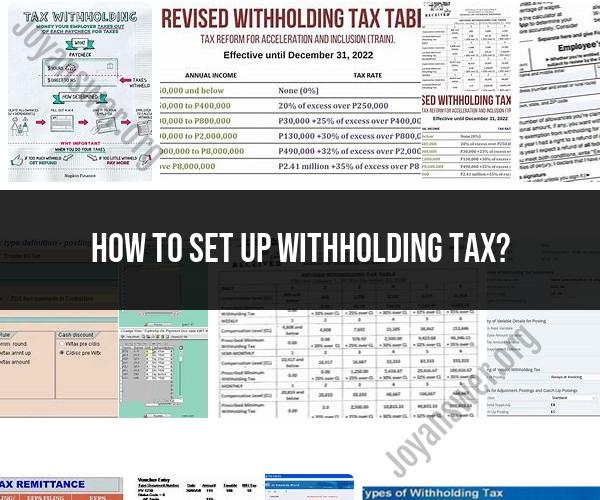How to set up withholding tax?
Setting up withholding tax for your business involves several steps to ensure that the correct amount of income tax is withheld from your employees' paychecks and remitted to the tax authorities. Here's a general guide on how to set up withholding tax as an employer:
Obtain an Employer Identification Number (EIN):
- If you haven't already, obtain an EIN from the Internal Revenue Service (IRS). This unique identifier is necessary for tax reporting and withholding purposes.
Determine Employee Withholding Status:
- When hiring employees, have them complete IRS Form W-4, Employee's Withholding Certificate. This form helps determine each employee's withholding status, including their filing status and the number of withholding allowances they claim.
Calculate Withholding Amounts:
- Use the information provided on Form W-4 to calculate the amount of federal income tax to withhold from each employee's paycheck. You can use IRS Publication 15, Employer's Tax Guide, or an online payroll system to assist with calculations.
Set Up a Payroll System:
- Implement a payroll system that can calculate and withhold the correct amount of federal income tax, as well as any applicable state and local taxes. Many payroll software solutions automate this process.
Determine State and Local Withholding Requirements:
- Depending on your business location, you may also be required to withhold state and local income taxes from employees' paychecks. Consult your state's tax agency and local tax authorities to determine the specific requirements.
Withhold and Deposit Taxes:
- Withhold the calculated taxes from each employee's paycheck. Pay close attention to deposit deadlines for both federal and state withholding taxes, as these vary depending on the size of your payroll and tax liability.
File Quarterly and Annual Returns:
- Submit quarterly federal payroll tax returns (Form 941) to report the taxes you've withheld from employees' paychecks. Also, file an annual return (Form 940) to report federal unemployment taxes. State and local tax authorities may have their own filing requirements.
Provide Year-End Forms:
- At the end of each calendar year, provide employees with Form W-2, Wage and Tax Statement. This form summarizes their earnings and tax withholdings for the year. Send a copy to the Social Security Administration (SSA) as well.
Maintain Records:
- Keep thorough records of payroll, including copies of Form W-4 for each employee, payroll registers, tax filings, and payment receipts. Retain these records for the required retention period, typically at least three years.
Stay Informed and Compliant:
- Regularly review tax laws and regulations to ensure compliance with changes in withholding tax rates or requirements. Be prepared to update your payroll system and procedures accordingly.
Seek Professional Assistance:
- If you're uncertain about tax withholding requirements or encounter complex payroll scenarios, consider consulting with a tax professional or using a payroll service provider to ensure accurate withholding and compliance.
Setting up and managing withholding tax is a critical responsibility for employers to fulfill their tax obligations and avoid penalties. It's essential to stay informed, maintain accurate records, and seek professional guidance when necessary to ensure compliance with tax laws and regulations.













